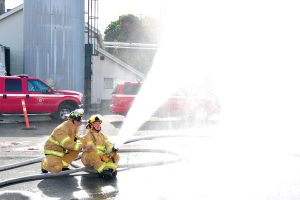Fireboat demonstrates a unique capability
By Lookout on Nov 03, 2014 with Comments 0

Pat Dunkley and Steve Cullimore take part in an exercise with the Firebrand firefighting vessel during the Great BC Shakeout.
Two week ago, base firefighters exercised with Firebrand, the Pacific Coast navy’s fireboat, to test its ability to become a portable water-side “hydrant.”
When fighting a fire from the water, Firebrand can employ its three water cannons and fire suppressant foam from its two 250 gallon tanks.
But it can also be used to fight land fires by becoming a portable water main.
“If we have to fight a fire in an engine room of a warship, then Firebrand can use its master streams to cool the hull from the outside. Lowering the temperature of the steel hull hinders heat transfer from the fire-involved space to adjacent compartments,” explains Steve Mullen, Fire Chief at CFB Esquimalt Fire Department. “If we have to fight a jetty fire, using Firebrand is more effective than hanging firefighters off the side of a ship or jetties. It just makes our job a lot safer in a lot of situations.”
The exercise took place Oct. 16 on B jetty with Firebrand berthed alongside. The scenario tested was an emergency where land-based fire mains were damaged or destroyed and Firebrand was brought in to help firefighters combat a blaze.
Should an earthquake occur, one of the first pieces of critical infrastructure to be destroyed could be the water distribution system. Firebrand’s 5,000 gallon-per-minute-pump can supply a high volume of pressurized sea water into a system of hoses, gated wyes, and portable hydrants. This provides the fire department with enough water to fight structural fires ashore.
“It can mean the difference between having what you need to suppress or extinguish a blaze, and stretching your water supply to dangerous limits,” says Mullen. “There have been some historic fires around the world such as San Francisco in 1989, where vessels like this were the difference between success and failure.”
He also sites a much-closer-to-home scenario – that of the 1997 fire aboard the Russian fishing trawler “Gijon” at the Esquimalt Graving Dock.
“There were so many trucks and fire crews; they ran the risk of demand overtaking water supply, and collapsing the water main,” says Mullen. “Firebrand supplied all of those fire apparatus and hoses with water, and the crews were able to fight that fire for almost three days. Without the Firebrand it would have been a very different situation.”
Cdr David Coulombe, head of Port Operations and Emergency Services Branch, says assets such as Firebrand are a great tool to have in a firefighter’s response kit.
“I deployed with Canada’s Disaster Assistance Response Team (DART) to Haiti in 2010. The DART assisted the community of Jacmel in southern Haiti to rebuild its water system after it was severely damaged in the quake. It is likely that our water mains would be damaged after a major quake, and we have to be prepared to conduct fire fighting operations even if that were to occur.”
Shawn O’Hara, Staff Writer
Filed Under: Top Stories
About the Author:





